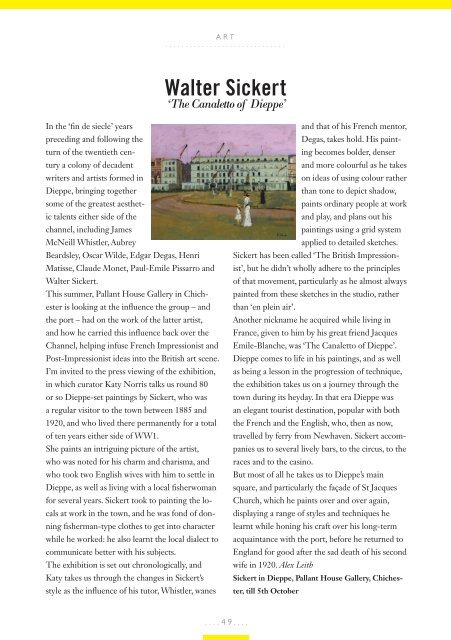You also want an ePaper? Increase the reach of your titles
YUMPU automatically turns print PDFs into web optimized ePapers that Google loves.
ART..............................Walter Sickert‘The Canaletto of Dieppe’In the ‘fin de siecle’ yearspreceding and following theturn of the twentieth centurya colony of decadentwriters and artists formed inDieppe, bringing togethersome of the greatest aesthetictalents either side of thechannel, including JamesMcNeill Whistler, AubreyBeardsley, Oscar Wilde, Edgar Degas, HenriMatisse, Claude Monet, Paul-Emile Pissarro andWalter Sickert.This summer, Pallant House Gallery in Chichesteris looking at the influence the group – andthe port – had on the work of the latter artist,and how he carried this influence back over theChannel, helping infuse French Impressionist andPost-Impressionist ideas into the British art scene.I’m invited to the press viewing of the exhibition,in which curator Katy Norris talks us round 80or so Dieppe-set paintings by Sickert, who wasa regular visitor to the town between 1885 and1920, and who lived there permanently for a totalof ten years either side of WW1.She paints an intriguing picture of the artist,who was noted for his charm and charisma, andwho took two English wives with him to settle inDieppe, as well as living with a local fisherwomanfor several years. Sickert took to painting the localsat work in the town, and he was fond of donningfisherman-type clothes to get into characterwhile he worked: he also learnt the local dialect tocommunicate better with his subjects.The exhibition is set out chronologically, andKaty takes us through the changes in Sickert’sstyle as the influence of his tutor, Whistler, wanesand that of his French mentor,Degas, takes hold. His paintingbecomes bolder, denserand more colourful as he takeson ideas of using colour ratherthan tone to depict shadow,paints ordinary people at workand play, and plans out hispaintings using a grid systemapplied to detailed sketches.Sickert has been called ‘The British Impressionist’,but he didn’t wholly adhere to the principlesof that movement, particularly as he almost alwayspainted from these sketches in the studio, ratherthan ‘en plein air’.Another nickname he acquired while living inFrance, given to him by his great friend JacquesEmile-Blanche, was ‘The Canaletto of Dieppe’.Dieppe comes to life in his paintings, and as wellas being a lesson in the progression of technique,the exhibition takes us on a journey through thetown during its heyday. In that era Dieppe wasan elegant tourist destination, popular with boththe French and the English, who, then as now,travelled by ferry from Newhaven. Sickert accompaniesus to several lively bars, to the circus, to theraces and to the casino.But most of all he takes us to Dieppe’s mainsquare, and particularly the façade of St JacquesChurch, which he paints over and over again,displaying a range of styles and techniques helearnt while honing his craft over his long-termacquaintance with the port, before he returned toEngland for good after the sad death of his secondwife in 1920. Alex LeithSickert in Dieppe, Pallant House Gallery, Chichester,till 5th October....49....


















